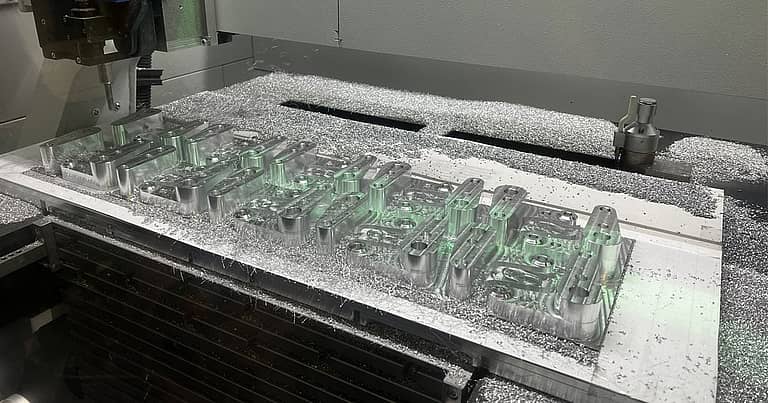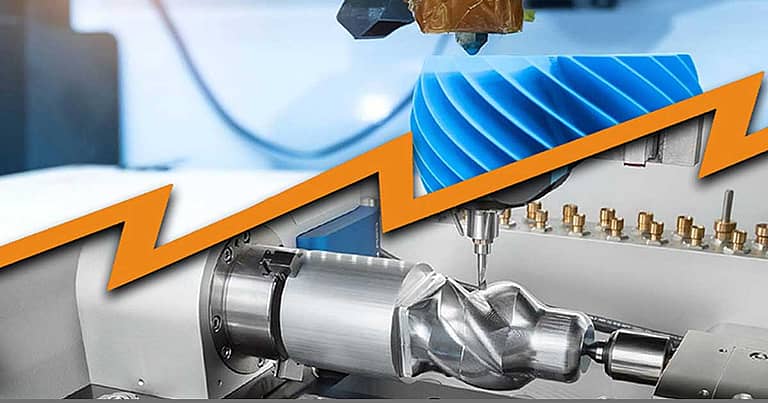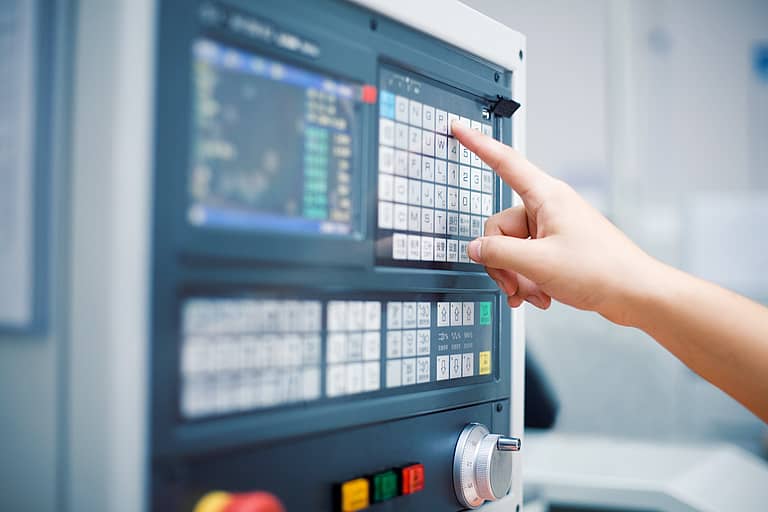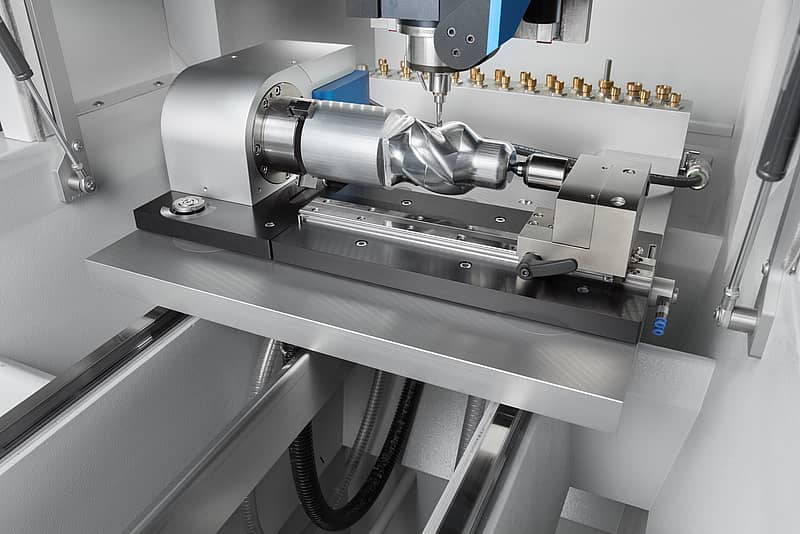
Whether you are a seasoned professional in the industry or someone just beginning to explore the world of machining, understanding the nuances and differences between CNC vs manual machining is essential.
In this blog, we investigate the intricacies of both machining processes, exploring the strengths, limitations, skills needed, cost, and more to consider when choosing between them. First, let’s discuss what is CNC machining and what is manual machining before we get into comparing the two!
What is CNC Machining?
Computer Numerical Control machining is a manufacturing process where pre-programmed computer software dictates the movement and tools. It operates through a series of numerical codes, guiding the machinery to produce complex shapes and components from various materials such as metals, plastics, wood, and composites.
In CNC machining, a computer controls the movement and operation of precision machining tools such as mills, lathes, routers, grinders, and lasers. The process typically involves creating a digital design (CAD) of the desired part, which is then converted into a set of instructions (G-code) that the CNC machine follows to execute the manufacturing process.
CNC offers several advantages over conventional machining methods, including increased accuracy, repeatability, and efficiency. It also allows for the production of highly precise and intricate parts with minimal human intervention, making it widely used in various industries such as aerospace, automotive, electronics, medical, and prototyping.
What is Manual Machining?
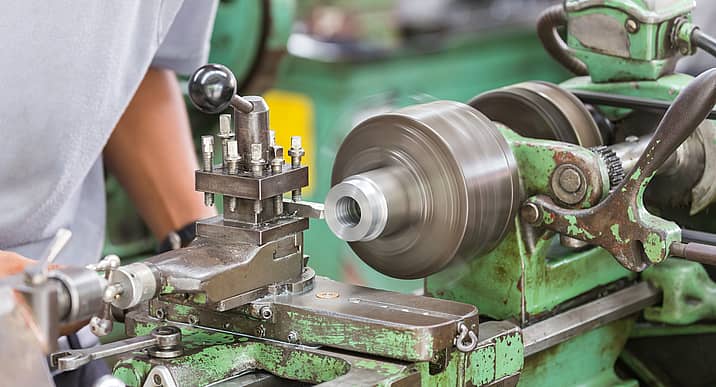
Manual machining refers to the process of shaping, cutting, or forming materials using manually operated machine tools such as lathes, milling machines, drill presses, grinders, and saws. In manual machining, the operator controls the movement of the cutting tool or the workpiece by hand, using handwheels, levers, or other manual controls.
Manual machining requires skill and precision on the part of the operator to produce accurate and high-quality parts. It involves tasks such as turning cylindrical parts on a lathe, milling flat or contoured surfaces using a milling machine, drilling holes to precise depths and diameters, grinding surfaces to achieve specific finishes, and cutting materials to size using saws.
While manual machining has been largely supplanted by CNC machining in many industrial settings due to its higher automation and precision, manual machining is still used in certain applications, particularly in small-scale manufacturing, repair shops, and prototyping where the volume of work does not justify the investment in CNC equipment, or where the flexibility of manual control is advantageous.
Comparing CNC vs Manual Machining
Now that you know the fundamentals of a CNC machine and a manual machine, it’s time to compare CNC machining vs manual machining. We will cross-examine the two machines based on topics such as precision, complexity, skill requirements, and cost, to name a few!
Precision
When it comes to precision, you can rely on CNC machines to precisely control the movement of the cutting tools and workpieces with the automated control ensuring consistency and accuracy. CNC machines also excel in repeatability, meaning they can reproduce the same operations with high precision across multiple workpieces. Once a program is set up correctly, CNC machines can maintain tight tolerances consistently.
CNC machines often incorporate advanced features such as feedback mechanisms, tool monitoring systems, and automatic tool changers, which further enhance precision and accuracy. Also, many CNC machines are capable of multi-axis machining which enables them to achieve high precision in three-dimensional parts.
The precision of manual machines heavily relies on the skill and experience of the operator. Skilled machinists can achieve high levels of precision through careful manipulation of machine controls and cutting tools. Manual machines require operators to manually control the movement of cutting tools and workpieces, which introduces the potential for human error and inconsistencies.
It is also true that some manual machines lack the automated features found in CNC machines, such as digital readouts, automatic tool feed, and computerized positioning systems, which can impact precision and repeatability. While manual machines may be capable of achieving precise results, they are generally more suited for simpler geometries and less intricate part designs compared to CNC machines.
Complexity
CNC machines offer unparalleled flexibility in programming complex parts. CAD/CAM software enables users to create intricate toolpaths, including multi-axis movements, curves, and contours, allowing for the machining of highly complex parts. Also, many CNC machines are equipped with multiple axis (3-axis, 4-axis, 5-axis, or even more), enabling them to perform complex machining operations from various angles both quickly and efficiently. The high levels of automation provided by CNC machining reduces the need for manual intervention and minimizes setup times.
Just like CNC machines, manual machines also require highly skilled operators to perform the necessary functions to complete complex parts. However, manual machines are limited due to the lack the automation features found in CNC machines, and as a result, setup times may be longer, and machining operations may require more manual intervention.
Not to mention, making complex parts on a manual machine may pose challenges in tool selection, toolpath planning, and workpiece fixturing. This means setting up a manual machine for complex parts can be time-consuming, especially for intricate parts or tight tolerances. Operators may need to perform multiple trial-and-error adjustments to achieve desired results, leading to longer lead times and higher labor costs.
Productivity and Efficiency
Once again, CNC tends to be more productive and efficient for high-volume production runs or complex parts with tight tolerances. Once programmed, these machines can run continuously with minimal downtime, resulting in faster turnaround times and higher throughput. Automation features, such as tool changers, pallet changers, and robotic loading/unloading systems, further enhance productivity by reducing manual intervention and setup times.
However, manual machines may be more suitable for low-volume production runs or simpler tasks where flexibility and adaptability are paramount. While manual machines may have slower cycle times compared to CNC machines, they offer more options and can accommodate a wider range of machining tasks and materials. Skilled machinists can optimize manual processes to maximize efficiency and quality, but they may require more time and effort to set up compared to CNC. Note that the lack of automated cooling and chip collection features can reduce the efficiency of the machining process compared to that of a CNC machine.
Skill Requirements
CNC machinists need to have a strong understanding of computer programming languages such as G-code and CAM (Computer-Aided Manufacturing) software. This means that they must be able to read and interpret technical drawings and translate them into CNC programs. While CNC machines handle most of the physical machining tasks automatically, operators must still possess skills in machine setup, tooling selection, and fixture design. CNC machinists must have an eye for detail to inspect finished parts and should be familiar with measurement tools such as micrometers and calipers, but this is also true for manual machinists as well.
Manual machinists require excellent coordination and manual dexterity to operate various machine tools such as lathes, milling machines, and grinders. They manipulate cutting tools to shape raw materials into finished parts. Manual machinists also need a deep understanding of different materials, including metals, plastics, and composites. They must know how each material responds to cutting forces, heat, and other machining parameters.
Manual machining often involves selecting the appropriate cutting tools, setting cutting speeds and feeds, and adjusting based on material properties and desired outcomes. Having a thorough understanding of tool geometry, tool materials, and cutting techniques is an absolute must-have for CNC and manual machinists.
Training
When it comes to training, many CNC machinists obtain education through technical schools, vocational programs, or community colleges, where manual machining is taught first to learn the basic principles before moving to CNC machining. This is where they learn machining fundamentals, CNC programming, and machine operations, although this is not always the case. Most CNC machinists undergo on-the-job training under experienced mentors or supervisors to familiarize themselves with specific machines, software, and processes used in their workplace. Given the rapid advancements in CNC technology, machinists need to stay updated with the latest software programs, machining techniques, and industry standards.
Traditionally, manual machinists undergo apprenticeship programs where they receive hands-on training under experienced mentors. They learn techniques, tool handling, machine setup, and safety practices over several years. Much of the expertise in manual milling is gained through practical experience on the shop floor. Machinists gradually refine their skills by working on different projects and tackling various machining challenges, which is like a CNC machinist journey as well.
Initial Expense
CNC machines are typically more expensive upfront compared to manual machines. The cost varies depending on the type of CNC machine, size, capacity, and features. High-precision CNC machines equipped with advanced automation and multi-axis capabilities can be particularly costly and require an investment in CAM software for programming and toolpath generation. Additionally, automation advancements such as tool changers and probing require a larger up-front cost to increase the efficiency of your workflow.
Setting up a CNC machining facility may also require additional infrastructure, such as climate-controlled environments, coolant systems, and dust extraction equipment, which can contribute to initial investment costs.
Manual machines, such as lathes, milling machines, and grinders, tend to be less expensive upfront compared to CNC machines. However, the cost can still vary depending on the size, capacity, and features of the machine. Basic manual machines may be more affordable for smaller workshops or hobbyists. While manual machining also requires an investment in tooling, the cost may be lower compared to CNC machining, as manual machines often use conventional cutting tools that are less specialized and expensive.
Manual setups may require fewer infrastructure investments compared to CNC, as they generally don’t rely on complex automation systems or specialized facilities. However, manual machines are dirtier and more dangerous to run without the protective covers that come with CNC machines, so additional safety and cleaning set-ups will need to be set in place, potentially increasing the initial cost.
Operating Costs
CNC typically requires fewer operators compared to manual machining, as one operator can oversee multiple CNC machines simultaneously. However, CNC machinists tend to command higher wages due to their specialized skills in programming, setup, and operation.
It is also to be noted that CNC machines may consume more energy due to their continuous operation and reliance on motors, coolant systems, and other auxiliary equipment. Energy costs contribute to the overall operating expenses of CNC machining as well as the cost of regular maintenance. This includes routine servicing, calibration, and occasional repairs or upgrades to machine components, control systems, and tooling holding solutions.
Manual machining often requires more labor-intensive operations which can result in higher labor costs, especially for complex or time-consuming projects that require skilled machinists. Manual machines generally consume less energy compared to CNC machines since they rely on manual input rather than continuous motorized operation. However, energy costs may still be a factor depending on the size and type of manual machines used.
Manual machines also require regular maintenance to ensure they remain in good working condition. While maintenance costs may be lower compared to CNC machines, manual machines may experience wear and tear on manual controls and other components as well. However, the small footprint of the machine can save costs on the shop floor compared to much larger CNC machines.
Decide Which Machine is Right For You!
Now you know the differences between CNC vs manual machining and how each method works in the space of modern manufacturing with their unique advantages and challenges. CNC machining shines in terms of precision, versatility, and efficiency, making it the preferred choice for high-volume production and complex components. On the other hand, manual machining retains its relevance for specialized applications, prototyping, and low-volume production where flexibility and hands-on expertise are paramount.
Ultimately, the decision hinges on factors such as project requirements, budget constraints, and desired outcomes. By understanding the nuances of each approach and evaluating their respective strengths and weaknesses, you can now make an informed choice to optimize your machining processes and drive success in today’s competitive market landscape.
If you are still on the fence about which option is best for your manufacturing needs, give us a call, and our DATRON experts will be able to help you decide if our high-speed CNC machines are the right choice for you!




